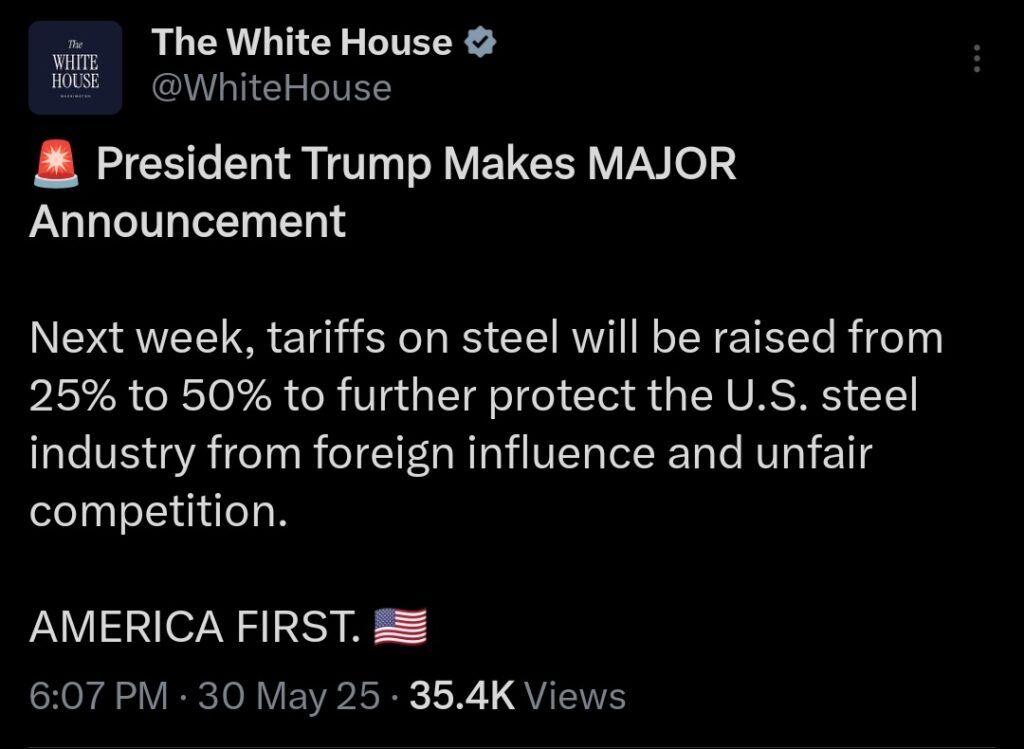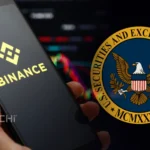President Donald Trump announced a dramatic hike in tariffs on imported steel and aluminum during a campaign-style rally on Friday, doubling the current 25% rate to 50%. The new tariffs will take effect June 4, and they’re already roiling markets and rattling America’s closest trade partners.
“We’re going to bring it from 25% to 50% — the tariffs on steel into the United States of America,” Trump declared at the U.S. Steel’s Mon Valley Works in West Mifflin, Pennsylvania. “This will even further secure the steel industry in the United States.”
The announcement, made just outside Pittsburgh — a key electoral battleground — follows Trump’s claims that China has violated agreements with the US on critical mineral trade. The White House later confirmed the 50% levy would also apply to aluminium products.
Stocks Soar, Allies Fume
The market reacted swiftly. Shares of Cleveland-Cliffs Inc. surged 26% after hours, as investors bet the higher tariffs would boost profits for domestic steelmakers.
But while US steel stocks jumped, international condemnation was immediate:
- Canada’s Chamber of Commerce called the move “antithetical to North American economic security.”
- Canada’s United Steelworkers union slammed the hike as a direct attack on Canadian workers.
- The European Commission warned of “countermeasures,” calling the tariffs harmful to global growth and transatlantic trade.
- Australia’s Trade Minister labeled the decision “unjustified and not the act of a friend.”

A Familiar Strategy, Bigger Scale
This isn’t Trump’s first move in the global trade war — but it may be one of his most aggressive. The US imported 26.2 million tons of steel in 2024, and the 289 categories affected by the new tariffs amounted to $147.3 billion in imports last year.
The new levies fall under Section 232 of the Trade Expansion Act, which allows tariffs on national security grounds. A wide range of goods will be impacted — from steel door hinges and gas ranges to aluminum frying pans and horseshoes.
Trump had already enacted 25% tariffs upon returning to office in January, but now, with the election season in full swing, the escalation is clearly aimed at energizing Rust Belt voters and boosting domestic manufacturing.
Political and Economic Ramifications
Friday’s speech tied the tariff hike to a proposed $14.9 billion deal between Nippon Steel and U.S. Steel, another move Trump framed as a jobs-saver. But the broader impact could be higher prices across US industries — and a new wave of trade retaliation from major partners.
“This decision adds further uncertainty to the global economy and increases costs for consumers and businesses on both sides of the Atlantic,” said a European Commission spokesperson.
While popular in certain blue-collar regions, Trump’s trade strategy risks reviving the same global tensions that rocked markets during his first term. And with fresh retaliation looming, the cost of economic nationalism may soon reach beyond the Rust Belt.
Disclosure: This article does not represent investment advice. The content and materials featured on this page are for educational purposes only.
Related:
SEC Drops Binance Lawsuit in Major Win for Crypto – Trump-Linked Ventures Surge Ahead
From Chips to Humanoids: Nvidia CEO Jensen Huang Bold Vision for Future
Trump Taps Palantir to Build Massive Government Spy Network
Germany Considers 10% Digital Tax on Google, Meta – Risks New Clash With Trump
Appeals Court Reinstates Trump’s Tariffs – Legal Battle Heats Up
JD Vance: Bitcoin Is America’s Strategic Weapon Against China
US trade court blocks Trump’s sweeping tariffs. What happens now?
Trump orders US chip designers to stop selling to China
US Consumer Confidence Soars in May Amid Hopes for Trade Peace










